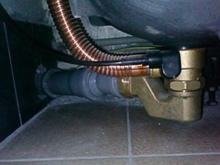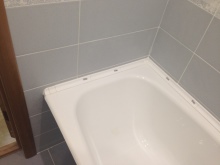How to install a bathtub on legs: the secrets of proper installation
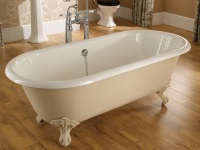
To date, there are several options for installing a bathtub. The most popular of them are support legs and a brick base. The first method is chosen by those who seek to leave as much free space as possible, even in such a small room as a bathroom.
If the bath rests on legs, the floor underneath it remains free. This means that you will have fewer problems with cleaning, and you can always make minor repairs to the plumbing under the tub without removing the support. In addition, open access to the space under the bathtub allows you to constantly keep this area clean, in time to remove puddles of water, dirt and objects that got there during bathing.
In addition to standard mounting feet, there is a wide range of decorative supports, which will look great in the interior, stylized for classic, baroque and other retro trends.
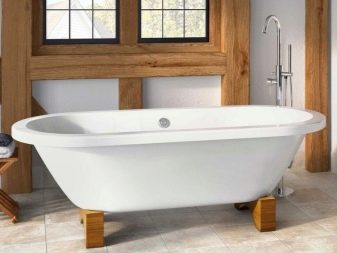
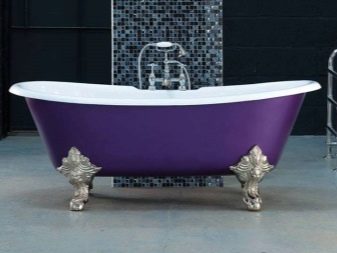
Read about what the rules of installation on the legs are for different types of bathtubs in our article today.
Varieties of bathtubs on legs
Cast iron
The very first baths launched in mass production were made of cast iron. This material is incredibly durable and hard-wearing - a cast-iron bath will serve its owners for decades, without losing its original properties. Cast iron plumbing is distinguished by durability, good thermal conductivity and unpretentiousness in care. Its disadvantage is that cast iron is very heavy, which complicates the transportation and installation of sanitary equipment made of this material.
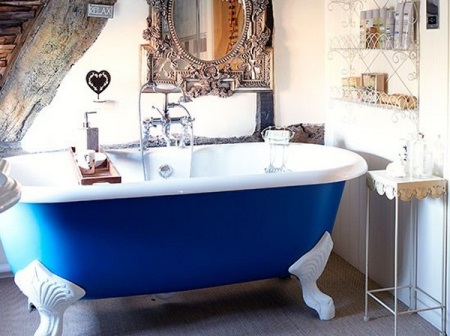
Steel
Steel - the material is quite durable, but not as heavy as cast iron, so it is more popular with customers. Another plus in its favor - steel plumbing belongs to the budget class. The steel bathtub is easy to install and it is not difficult to take care of. Major disadvantages of such a bath would be two: a short service life and a complete lack of noise insulation.

Acrylic
Acrylic is a more modern and expensive material than cast iron and steel. Today not only bathtubs are made of acrylic, but also other types of sanitary equipment. Acrylic sanitary ware has a beautiful appearance, pleasant to the touch and, most importantly, non-slip surface. Disadvantage of acrylic bathtubs is the brittle structure of the material, which excludes the use of cleaning products that contain aggressive substances in their composition.
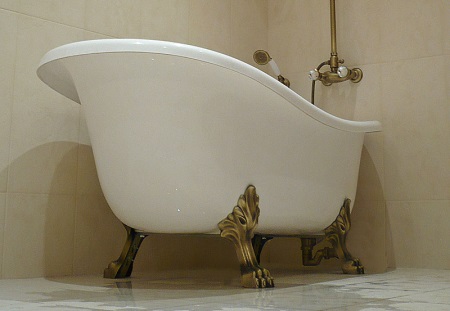
In addition to the above three materials, in the range of stores that sell sanitary ware, there are baths made of plastic, kvaril, marble and other materials of both artificial and natural origin. We will not dwell on them in detail, as our task is to tell about the most common varieties of baths.
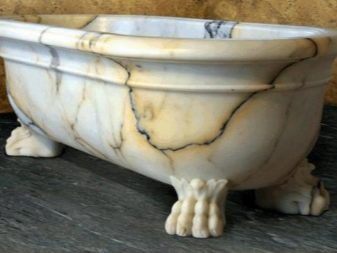
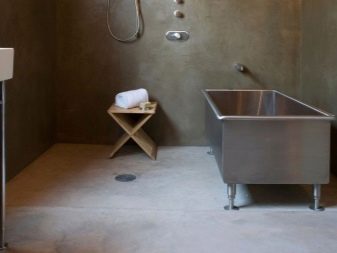
Required tools and materials
In order to set the tub on its feet, regardless of the material of its manufacture, you will need the following supplies and equipment:
- A pencil or washable marker;
- tape measure;
- Construction level;
- a set of adjustable legs;
- a support frame for the font;
- set of fasteners;
- silicone-based sanitary sealant;
- a drill or a rotary hammer with a set of drill bits.

Preparatory works
Before proceeding directly to the installation of sanitary equipment, it is necessary to prepare the working space. To begin with, it is necessary to dismantle the old bathtub.
Together with the bathtub, it is desirable to replace the entire system of drain overflow, so without regret remove the old siphon, faucet, etc. Do not forget to shut off the hot and cold water supply in the bathroom beforehand.
If necessary, clean the floor and walls in the area where the bath will be installed from the remains of building materials. Clean all surfaces of dirt and mold. After that, it is recommended to treat the floor with a special antibacterial composition that prevents the formation of mold and mildew.
Remove all debris from the floor and cover it with cellophane or old newspapers. The workplace is ready, you can begin mounting the tub on its feet.
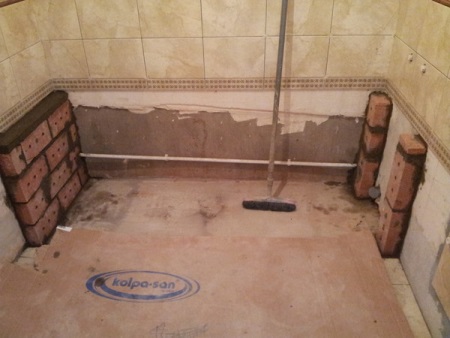
Installing a Cast Iron Bathtub
- Since the floors in our apartments are often not at all flat, on each of the supporting legs is recommended to begin by installing adjustment screws. With their help, you will later be able to level the tub horizontally so that the overflow drain system will work properly.
- First, two of the front legs and then the two back legs are fastened to the tub in pairs. There are several options for fastening - "Velcro" (legs on the self-adhesive basis), wedges and coupling bolts. The adhesive-based feet should simply be pressed against the bottom of the tub for a few seconds. The wedges are hammered into the pre-drilled holes. The tension bolts are also inserted into the holes and screwed tight.
- The second pair of legs is attached to the bathtub that has already been turned upside down. The side that has no legs is supported by a solid support that can sustain the weight of the cast-iron bathtub.
- When all four legs will be in place, you should align the bath horizontally. Use a construction level for this purpose. Pay special attention to the sides that are adjacent to the walls. The gap between the wall and the edge of the baptismal font should be as small as possible.
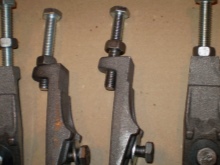
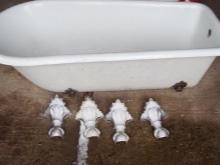
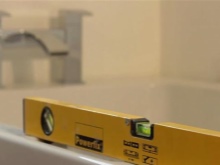
Installing the steel bathtub
Installation of the legs on the steel bath is much easier, because the sanitary device made of steel weighs several times less than a similar one made of cast iron.
- Turn the bathtub upside down and measure the supporting feet on the mounting points. The first pair of legs should be positioned between the center of the pan and the drain hole, about two centimeters from the latter. The second pair will need to be installed as close as possible to the opposite edge of the baptismal font.
- If necessary, the supporting metal profile is carefully straightened, taking care not to damage the tub.
- The support legs are usually attached to the steel bathtub using adhesive-based plates. Before you remove the protective film from the plates and glue the legs to the bottom of the tub, degrease the fastening places. Any solvent or alcohol solution will do. Warm the plates with glue, remove the protective film and firmly press each of the legs to the bottom.
- After the glue has set, you need to attach the adjusting studs to the legs. They are threaded, so you can just hammer them into the plastic lugs. Then firmly fix the studs on the legs with the nuts.
- Using a construction level, find the correct position for the steel tub in the horizontal plane. We make a marking on the walls and, according to it, install the tub in place.
- If desired, you can glue some plates for soundproofing.

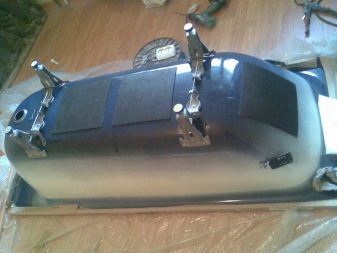
Installing the acrylic bath
Acrylic bathtubs are designed, more often than not, exactly for installation on the legs. This makes it much easier for us, because a set of supports and fasteners, as a rule, comes with the device, and the sequence of steps is described in detail in the installation instructions.
- As in all previous cases, the first thing to do is to try on the support legs to the mounting location and make a marking.
- The next step is to drill holes. Acrylic is a fragile material, so you should by no means drill through the tub. Be sure to use a drill bit limiter.
- Then install the main fixing elements on the bath - guides for the frame and supporting legs.
- Now you need to mount the overflow and drain system and install it in place. The acrylic bathtub is mounted to the wall with a siphon.
- Turn the bathtub with the bottom down and take it to the place of installation. We take a construction level and determine the optimal position for it. Leave a marking on the walls.
- According to the markings, mount mounting hooks to the wall. They will give the structure additional strength and protect the tub from deformation.
- Now you can safely install the bathtub in place, because it will be supported not only by legs, but also by metal hooks.

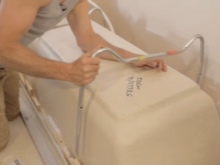

The final stage
After all the installation work is over, you need to do a lot of small but important things.
- Install the faucet and overflow-drain system (if you did not do this in the main stage). Connect the bathtub to the water pipes.
- Now we need to check our construction for leaks: close the drain and fill the tub with water. After a few hours, thoroughly inspect all connections for leaks. If any are found, remove them with a bathtub sealant.
- The next problem to be solved is caulking the gap between the wall and the bathtub. To do this, you can use one of the proven methods - sealant, curb tape or a corner for the bath.
- Finally, you need to take care that the not always attractive support structure was hidden from view. For this purpose, a decorative screen is usually installed under the bathtub. You can assemble it yourself from plasterboard and cover it with ceramic tiles, or you can buy a ready-made sliding screen made of plastic or plexiglass.
